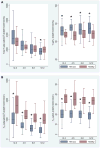Characteristics of lymphocyte subsets in HIV-infected, long-term nonprogressor, and healthy Asian children through 12 years of age
- PMID: 21134574
- PMCID: PMC3004741
- DOI: 10.1016/j.jaci.2010.09.038
Characteristics of lymphocyte subsets in HIV-infected, long-term nonprogressor, and healthy Asian children through 12 years of age
Abstract
Background: There are limited data on the immune profiles of HIV-positive children compared with healthy controls, and no such data for Asian children.
Objectives: To immunophenotype HIV-positive Asian children, including long-term nonprogressors (LTNPs), compared with age-matched healthy controls.
Methods: We used flow cytometry to analyze 13 lymphocyte and monocyte subsets from 222 untreated, HIV-positive children with 15% to 24% CD4(+) T cells and no AIDS-related illnesses and 142 healthy children (controls). Data were compared among age categories. Profiles from LTNPs (n = 50), defined as children ≥8 years old with CD4(+) T-cell counts ≥350 cells/mm(3), were compared with data from age-matched non-LTNPs (n = 17) and controls (n = 53).
Results: Compared with controls, HIV-positive children had lower values (cell count per mm(3) and percent distribution) for T(H) cells and higher values for cytotoxic T cells, with reductions in populations of naive T(H) and cytotoxic T cells, B cells, and natural killer (NK) cells. HIV-positive children had high values for activated T(H) and cytotoxic T cells. Compared with non-LTNPs, LTNPs had higher values of T(H) and cytotoxic T cells, naive and memory T-cell subsets, and B and NK cells. Surprisingly, counts of activated T(H) and cytotoxic T cells were also higher among LTNPs. LNTPs were more frequently male.
Conclusion: Untreated, HIV-infected Asian children have immune profiles that differ from those of controls, characterized by low values for T(H) cells, naive T cells, B cells, and NK cells but high values for cytotoxic, activated T(H), and cytotoxic T cells. The higher values for activated T cells observed in LTNPs require confirmation in longitudinal studies.
Trial registration: ClinicalTrials.gov NCT00234091.
Copyright © 2010 American Academy of Allergy, Asthma & Immunology. Published by Mosby, Inc. All rights reserved.
Conflict of interest statement
Figures



Similar articles
-
Distinct phenotype of unrestricted cytotoxic T lymphocytes from human immunodeficiency virus-infected individuals.J Clin Immunol. 2010 Mar;30(2):272-9. doi: 10.1007/s10875-009-9361-1. Epub 2010 Jan 23. J Clin Immunol. 2010. PMID: 20099013
-
Naïve CD4+ cell counts significantly decay and high HIV RNA levels contribute to immunological progression in long-term non-progressors infected with HIV by blood products: a cohort study.BMC Immunol. 2021 Jun 3;22(1):36. doi: 10.1186/s12865-021-00426-8. BMC Immunol. 2021. PMID: 34082709 Free PMC article.
-
Increased monocyte activation with age among HIV-infected long term non-progressor children: implications for early treatment initiation.HIV Med. 2019 Sep;20(8):513-522. doi: 10.1111/hiv.12751. Epub 2019 May 26. HIV Med. 2019. PMID: 31131542
-
Apoptosis of HIV-specific CD8+ T cells: an HIV evasion strategy.Cell Death Differ. 2005 Aug;12 Suppl 1:859-70. doi: 10.1038/sj.cdd.4401595. Cell Death Differ. 2005. PMID: 15818412 Review. No abstract available.
-
Immunophenotyping of T cell subpopulations in HIV disease.Curr Protoc Immunol. 2005 Mar;Chapter 12:Unit 12.12. doi: 10.1002/0471142735.im1212s65. Curr Protoc Immunol. 2005. PMID: 18432939 Review.
Cited by
-
Variation of B cell subsets with age in healthy Malawians.PLoS One. 2021 Jul 9;16(7):e0254320. doi: 10.1371/journal.pone.0254320. eCollection 2021. PLoS One. 2021. PMID: 34242324 Free PMC article.
-
HIV-1 Subtype C-Infected Children with Exceptional Neutralization Breadth Exhibit Polyclonal Responses Targeting Known Epitopes.J Virol. 2018 Aug 16;92(17):e00878-18. doi: 10.1128/JVI.00878-18. Print 2018 Sep 1. J Virol. 2018. PMID: 29950423 Free PMC article.
-
Advances in basic and clinical immunology in 2010.J Allergy Clin Immunol. 2011 Feb;127(2):336-41. doi: 10.1016/j.jaci.2010.11.042. J Allergy Clin Immunol. 2011. PMID: 21281863 Free PMC article. Review.
-
Cognition, Emotional Health, and Immunological Markers in Children With Long-Term Nonprogressive HIV.J Acquir Immune Defic Syndr. 2018 Apr 1;77(4):417-426. doi: 10.1097/QAI.0000000000001619. J Acquir Immune Defic Syndr. 2018. PMID: 29303843 Free PMC article.
-
Soluble CD163 and monocyte populations in response to antiretroviral therapy and in relationship with neuropsychological testing among HIV-infected children.J Virus Erad. 2015;1(3):196-202. doi: 10.1016/S2055-6640(20)30501-X. Epub 2015 Jun 30. J Virus Erad. 2015. PMID: 26835517 Free PMC article.
References
-
- UNAIDS. AIDS Epidemic Update 2009. [22 July 2010]. http://www.unaids.org/en/KnowledgeCentre/HIVData/EpiUpdate/EpiUpdArchive....
-
- Chearskul S, Chotpitayasunondh T, Simonds RJ, et al. Survival, disease manifestations, and early predictors of disease progression among children with perinatal human immunodeficiency virus infection in Thailand. Pediatrics. 2002;110(2 Pt 1):e25. - PubMed
-
- Paul ME, Mao C, Charurat M, et al. Predictors of immunologic long-term nonprogression in HIV-infected children: implications for initiating therapy. J Allergy Clin Immunol. 2005;115(4):848–55. - PubMed
Publication types
MeSH terms
Associated data
Grants and funding
LinkOut - more resources
Full Text Sources
Medical
Research Materials

